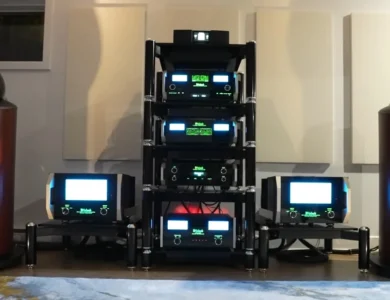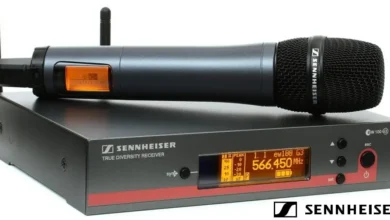For most people, a stereo or home theater system consists of a receiver into which audio and video sources are connected, paired with a set of speakers.
But if you’re interested in high-fidelity audio, you may know that other possible configurations can provide an enhanced listening experience.
Indeed, rather than relying on what is called an “integrated amplifier” (as in the example given above), some will replace this equipment with two separate devices: a preamplifier connected to a power amplifier. This is called a system with separate components.
Are you curious? In this article, our Ampreviews experts reveal what a preamplifier is, present its role, and explain how to choose one that meets your needs.
What is a preamplifier and what is its function?
Stereo preamplifiers and home theater preamplifiers are devices to which you connect your various audio and video sources ( CD player, Blu-Ray player, etc.).
Their role is to provide a certain amount of gain to the signal coming from these sources, before transmitting it to a power amplifier. Most preamplifiers therefore have a switch or buttons to select the source to be preamplified.

Preamplifiers also provide some sound processing. Moreover, depending on the preamplifier model, you can adjust the output volume, left-right balance, and tone via different types of controls.
In some cases, a preamplifier can also play a central role in a multi-room audio setup, either through multi-zone or wireless multi-room audio capability. Some can even allow you to stream music directly from Apple AirPlay or Bluetooth-enabled mobile devices, such as smartphones or tablets.
A preamplifier can also be equipped with a USB port for accessing compatible digital media content directly from plug-in flash drives or other compatible USB devices.
The difference between a preamplifier and an integrated amplifier
On the surface, a preamplifier doesn’t look much different from an integrated amplifier. What’s inside and on the back of these devices sets them apart.
The main difference is that a preamplifier usually needs to be paired with a second device to power a speaker system: a power amplifier. This is why many audio equipment brands produce both types of devices.

An integrated amplifier can act as both a preamplifier and a power amplifier. It is a sort of 2-in-1 device that can be connected directly to a set of speakers, unlike a preamplifier.
This is why the connectors that equip preamplifiers and integrated amplifiers (sometimes also called receivers ) differ. Both can have various inputs and outputs, but the integrated amplifier has speaker outputs, while the preamplifier usually does not. The latter will instead have RCA or XLR outputs that will be used to transmit the audio signal to a power amplifier, which in turn has speaker outputs.
It is nevertheless important to point out that a preamplifier could be connected directly to powered speakers.
What are the advantages of a preamplifier/power amplifier system?
After reading the first part of this text, you may be wondering why some people will opt for a preamplifier/power amplifier combo rather than choosing an integrated amplifier or a receiver.
Here are some advantages of a separate component system.
Superior sound quality due to better signal-to-noise ratio
In an integrated amplifier, the pre-amplification and signal amplification components are packed into a single box.
When the preamplifier and the power amplifier are two separate devices, designers have more freedom in electronic circuit design. For example, they can make signal paths shorter.
Also, the low-voltage sensitive preamp circuits are not as close to the high-voltage amplifier components. Not to mention, the preamp and amplifier don’t have to share the same power supply. Finally, some preamps have XLR output connectors, which are even quieter than RCA outputs.
All of these factors help to reduce interference that can cause background noise.
Greater flexibility
When you choose to combine a preamplifier and a power amplifier, you have the freedom to choose two devices that match your needs even more precisely. You don’t have to compromise.
Do you need maximum inputs or Bluetooth connectivity? You choose your preamp accordingly. If you need higher output power, opt for a power amplifier that offers you more than 300 Watts.
And if your requirements change at some point, a preamp/power amp system will allow you to simply replace the device that no longer meets your needs.
How to choose your preamplifier?
If you are looking to purchase a preamplifier, you will need to take the time to look at several models from different manufacturers and compare them based on specific points.
Check the inputs and outputs that the device has
When choosing a preamplifier, it is recommended to consider the type of inputs and outputs (HDMI, phono, RCA, USB, coaxial, XLR, etc.) that the device you are considering has, as well as their number.
For example, if you are looking for a device that will simply be used to listen to music, you do not need a preamplifier with HDMI inputs and outputs. However, you will need them if you are looking for a preamplifier for a home theater system.
Also, you should know that if you want to get the most out of a turntable, you should look for a preamplifier with a “phono” jack, designed specifically to handle the signal transmitted by this device.
When it comes to the number of inputs and outputs, it’s best to choose a device that has enough so that you don’t have to constantly fiddle with the connections on the back of the device when you change sources.
Determine what features you need
As mentioned earlier, preamplifiers can come with several features such as equalization, Bluetooth connectivity, and compatibility with apps like Apple Airplay or Google Chromecast.
Since adding these features can increase the price of a preamplifier, you should opt for a unit that has features you will use.
Also, in the case of home theater preamplifiers, do not unnecessarily choose a 15.4-channel preamplifier if your goal is to create a 5.1 system.
Make sure you choose a preamplifier that will be compatible with your power amplifier
Since preamplifiers are designed to be connected to a power amplifier, ensure these two devices are compatible.
One thing to watch out for is the preamplifier’s output impedance, which is usually expressed in ohms.
Set yourself a budget
As with many types of audio equipment, preamplifiers come in varying levels of quality. That’s why the price tag for a preamplifier can range from a few hundred dollars to several thousand dollars.
This price difference is usually justified by notable differences in the quality of the device’s components, the precision of the settings, the electrical insulation, and the construction of the case to name a few.
Remember, however, that it may be worth investing a little more for a high-fidelity model, as the quality of the preamplifier will have a direct effect on the sound quality of your stereo or home theater system.
Conclusion:
In conclusion, we hope that this article has been able to familiarize you with audio equipment whose role is often misunderstood and sometimes confused with that of a receiver, a power amplifier, or an integrated amplifier.
And if you ever need advice or want to be guided in choosing a preamplifier, know that our Ampreviews experts can offer you personalized support so that you can get your hands on a product that fits your needs and your budget. So, do not hesitate to contact us for a hassle-free service experience that can even include the installation of your stereo or home theater system.





GIPHY App Key not set. Please check settings